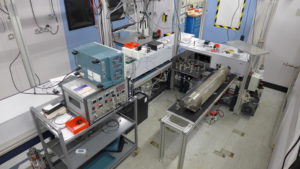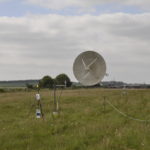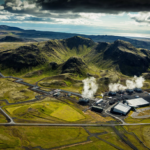ASPIC – Advanced Spectroscopy for improved characterisation of the near-Infrared water vapour Continuum
 In collaboration with the University of Reading, Department of Meteorology, the RAL Space Spectroscopy Group works on a four year NERC research project “Advanced Spectroscopy for improved characterisation of the near-Infrared water vapour Continuum” (ASPIC).
In collaboration with the University of Reading, Department of Meteorology, the RAL Space Spectroscopy Group works on a four year NERC research project “Advanced Spectroscopy for improved characterisation of the near-Infrared water vapour Continuum” (ASPIC).
Climate change driven by, for example, changes in concentrations of carbon dioxide, leads to further changes (or feedbacks) in the concentration of water vapour in the atmosphere. Water vapour is a strong absorber of infrared energy and the additional water vapour leads to a 50-100% increase in the warming that would otherwise occur. It also leads to significant changes in the partitioning of energy absorbed by the atmosphere and surface. This is known to exert a global level influence on the change in precipitation following climate change.
There are major knowledge gaps which inhibit a robust understanding of the global precipitation response to climate change. ASPIC will tackle some of these gaps via a wide-ranging study focusing on one important, but uncertain, component of absorption of infrared radiation by water vapour, known as the “continuum”. Under ASPIC, latest technological developments will be exploited to develop a new laboratory facility for measuring the water vapour continuum. This new facility will then be used to make a novel set of measurements. These measurements will then feed into detailed state-of-the-art calculations, which will examine the implications arising from the laboratory measurements for
our understanding of climate and climate change; these new detailed calculations will also incorporate other recent developments in the area, facilitating a rounded assessment.
The rather few existing laboratory measurements of water vapour continuum absorption in the so-called near-infrared wavelength region show marked disagreements, and a satisfactory explanation of these differences has proved elusive. Further, there are large uncertainties in how this absorption varies with temperature, and none of the existing measurements extend below “room temperature” to the temperatures widely experienced in the atmosphere. Following a successful pilot project, novel “super-continuum” lasers will, together with other advances, be exploited to make measurements of high-accuracy across the near-infrared wavelength region and across a temperature range more relevant to the atmosphere than earlier measurements. Two complementary spectroscopic techniques will be used to allow cross-checking of the results.
These results will then be incorporated into detailed radiative transfer calculations that will be used to significantly improve understanding of how absorption of solar radiation in the atmosphere will change as the climate warms, and water vapour concentrations increase. Existing calculations, which have used less-detailed methods, indicate strong uncertainties, with consequences for predictions of how rainfall will change in a warming climate.
The proposed measurements are inherently risky, given the difficulty of measuring the relatively weak infrared absorption under controlled laboratory conditions and the need to develop an advanced new measurement system which goes beyond the current status quo. Despite this risk, the gain from doing so successfully would be significant not only from a climate perspective, but also for measurement techniques that use this same wavelength region to monitor aerosols, clouds and the Earth’s surface. They would also contribute to understanding the fundamental spectroscopic properties of water vapour.
![]()
![]()
 Previous Post
Previous Post Next Post
Next Post